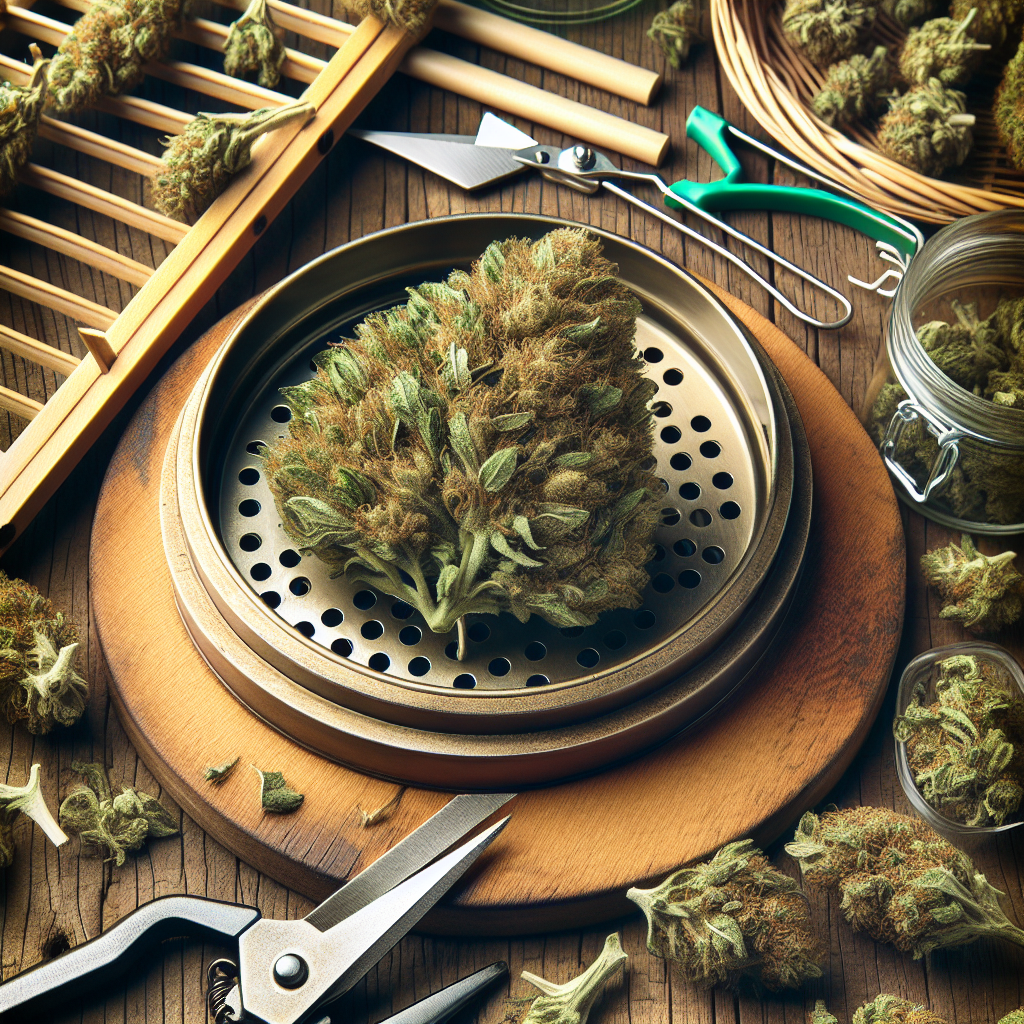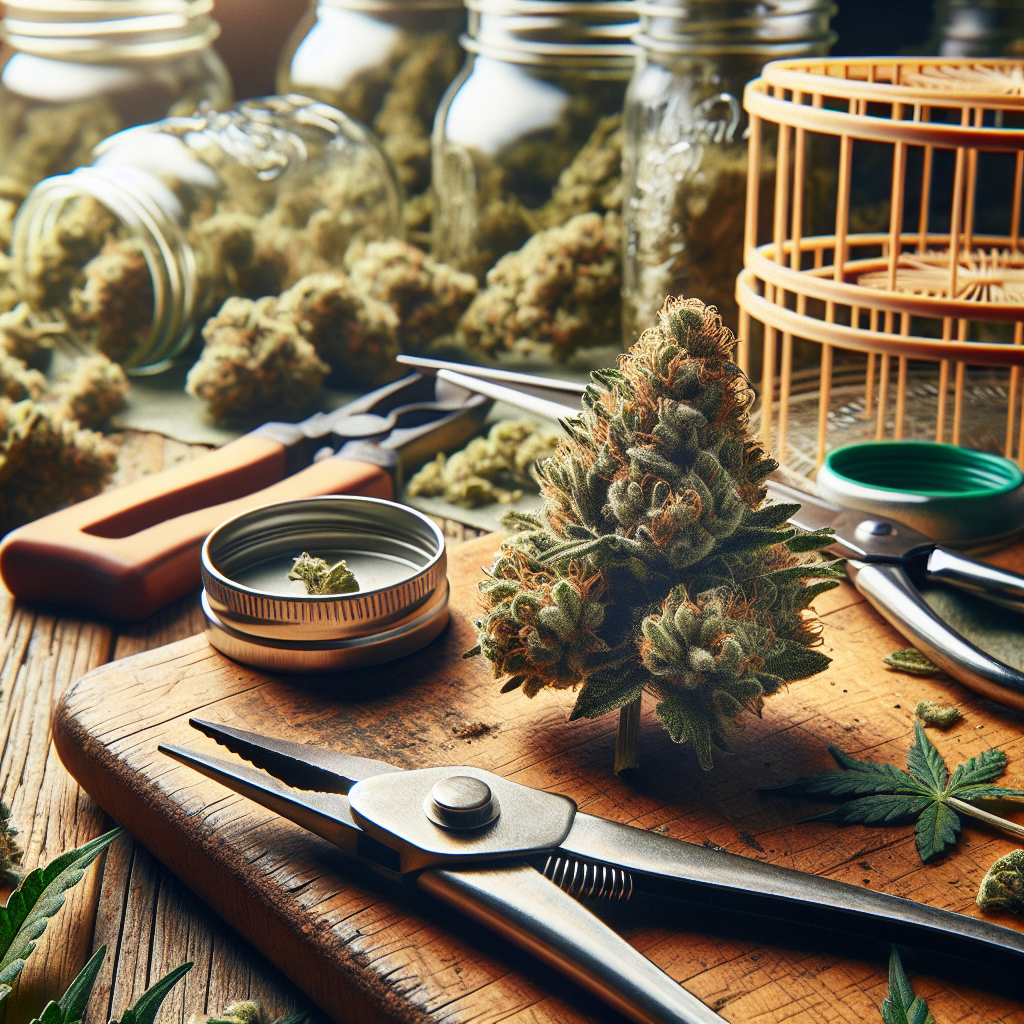Harvesting And Drying Cannabis Tips

Harvesting And Drying Cannabis Tips. You’ve spent countless hours tending to your cannabis plants, carefully nurturing them from seedlings to full-grown beauties. Now the time has come to harvest and dry your precious crop, and you want to make sure you do it right. In this article, we will provide you with some valuable tips on harvesting and drying cannabis, ensuring that you maximize the quality and potency of your harvest. From selecting the perfect time to harvest to properly curing your buds, we’ve got you covered. So grab your trimmers and get ready to learn the art of harvesting and drying cannabis like a pro.
Preparation for Harvesting
Determining the right time to harvest
Before diving into the process of harvesting, it is crucial to determine the perfect time to do so. Harvesting your cannabis plants at the right moment will ensure that you maximize the potency, flavor, and overall quality of your final product. The ideal time for harvesting is when the trichomes, the tiny resin glands on the buds, have turned cloudy or milky white. It’s also important to keep in mind that each strain may have different optimal harvesting windows, so it’s advisable to research the specific strain you are growing.
Gathering the necessary tools and equipment
To ensure a smooth and efficient harvesting process, it is essential to gather all the necessary tools and equipment beforehand. Some of the basic tools you will need include sharp scissors or pruning shears for cutting the plant, gloves to protect your hands from resin and sticky residue, and clean containers or bags for collecting the harvested buds. Additionally, having a clean and spacious workspace will greatly facilitate your harvesting process.
Preparing the drying area
Once you have determined the right time to harvest and gathered the necessary tools, it’s time to prepare an appropriate drying area. The drying area should be well-ventilated, dark, and have a controlled temperature and humidity level. It is advisable to set up a separate space solely dedicated to drying your cannabis plants, as this will minimize the risk of contamination and ensure optimal drying conditions. Make sure to clean the area thoroughly to avoid any potential mold or mildew contamination.
Harvesting Techniques
Cutting the main stem
When harvesting cannabis, the first step is to cut the main stem of the plant. This can be done using scissors or pruning shears. Start by cutting the main stem near the base of the plant, ensuring a clean and precise cut. By cutting the main stem, you will remove the plant from its root system, allowing for easier handling and drying.
Removing large fan leaves
After cutting the main stem, it is important to remove the large fan leaves. These leaves are not as resinous as the surrounding buds and can hinder the drying process if left attached. Use your fingers or scissors to carefully remove the fan leaves, working your way from the outer edges towards the center of the plant. Be gentle to avoid damaging the buds.
Trimming the remaining leaves
After removing the fan leaves, the next step is to trim the remaining sugar leaves surrounding the buds. Sugar leaves are the smaller leaves covered in trichomes. Trimming these leaves will enhance the overall appearance and quality of your final product. Use scissors or trimming shears to carefully remove these leaves, taking care not to damage the buds in the process. It is up to personal preference how much or how little to trim, but removing excessive foliage will result in a smoother smoke and a better taste.

Handling the Harvested Plants
Handling the plants with care
While handling the harvested plants, it is important to exercise caution and handle them with care. Cannabis buds are delicate and can easily get damaged or crushed if mishandled. Always handle the buds by the stem or gently hold them from the base to minimize the risk of damaging the trichomes or compacting the buds.
Avoiding contamination and damage
To maintain the quality of your harvested plants, it is crucial to avoid any potential contamination or damage during the handling process. This includes wearing gloves to prevent the transfer of oils or residue from your hands to the buds, as well as working in a clean and sterile environment. Additionally, avoid touching the buds excessively as this can lead to the loss of precious trichomes.
Transporting the plants properly
If you need to transport the harvested plants from one location to another, it’s important to do so in a secure and careful manner. Use clean, airtight containers or bags that will protect the buds from light, air, and humidity. Avoid overcrowding the containers to prevent compression or damage to the delicate buds. It is advisable to transport the harvested plants as soon as possible to maintain their freshness and prevent any degradation in quality.
Drying Methods
Air drying
Air drying is one of the most common and traditional methods of drying cannabis. It involves hanging the buds upside down in a cool, dark, and well-ventilated environment. This method allows for a slow and gradual drying process, which helps to preserve the flavor, aroma, and potency of the buds. Make sure to space out the buds properly to ensure adequate air circulation and prevent molding or uneven drying.
Drying in a controlled environment
For those who prefer a more controlled drying process, using a dedicated drying room or tent is recommended. This method allows you to fine-tune the temperature, humidity, and airflow to achieve optimal drying conditions. A drying room or tent equipped with fans, dehumidifiers, and a thermometer/hygrometer will give you better control over the drying process, resulting in a more consistent and higher-quality final product.
Using a drying rack or screen
Another option for drying cannabis is to use a drying rack or screen. This method involves laying the harvested buds on the surface of a rack or screen to allow for air circulation from all sides. Drying racks or screens are especially useful for small-scale growers or those with limited space. Make sure to regularly rotate the buds to achieve uniform drying and prevent any potential moisture buildup.

Proper Drying Conditions
Maintaining optimal temperature and humidity
Proper temperature and humidity conditions are crucial during the drying process to ensure a successful outcome. The ideal temperature for drying cannabis is between 60°F-70°F (15°C-21°C), while the relative humidity should be kept around 45%-55%. These conditions will facilitate a slow and controlled drying process, preserving the flavor, aroma, and potency of the buds. Avoid excessively high temperatures or low humidity levels, as they can lead to excessively fast drying, which compromises the quality of the final product.
Providing adequate air circulation
Adequate air circulation is essential for proper drying. Good airflow helps prevent the growth of mold and mildew and promotes even drying of the buds. Ensure that the drying area is properly ventilated, either through natural air flow or the use of fans or air circulation systems. Regularly check the buds for any signs of mold or excessive moisture, and adjust the airflow if necessary.
Avoiding direct sunlight
During the drying process, it is crucial to keep the harvested plants away from direct sunlight. Direct sunlight can lead to excessive heat, which can quickly dry out the buds and degrade the overall quality. It can also cause the breakdown of cannabinoids and terpenes, reducing potency and flavor. Instead, choose a dark and shaded area for drying, ensuring that any light sources nearby are not emitting UV rays.
Monitoring the Drying Process
Checking the moisture content
Regularly monitoring the moisture content of the buds is essential to prevent overdrying or moisture buildup. The best way to check the moisture content is by using a hygrometer, a humidity-measuring device. Ideally, the buds should be dried until they reach a moisture content of around 10%-15%. This can be determined by gently bending the branches of the dried buds. If they snap easily, it means they are dry enough.
Observing the color and texture of the buds
Observing the color and texture of the buds can also provide valuable insights into the drying process. Properly dried buds should have a uniform light green to golden color and a slightly crispy exterior. If the buds appear dark or overly dry, they may have been exposed to excessive heat or dried for too long. On the other hand, if the buds feel too moist or appear green, they may require additional drying time.
Assessing the smell
Another indicator of the drying process is the smell of the buds. Properly dried buds should have a strong, distinctive aroma. If the buds have a grassy or hay-like smell, it may be a sign of improper drying or inadequate airflow. Similarly, if the buds have a strong ammonia-like smell, it could indicate the presence of mold or mildew. Trust your senses and be vigilant in monitoring the smell of the drying buds.
Ensuring a Successful Drying Process
Avoiding mold and mildew
One of the biggest challenges during the drying process is preventing the growth of mold and mildew. To avoid this, maintain an optimal humidity level, ensure proper air circulation, and regularly inspect the buds for any signs of mold or mildew growth. If any areas of mold or mildew are detected, immediately remove the affected buds to prevent further contamination. It’s better to sacrifice a few buds than to risk a complete loss due to mold contamination.
Preventing overdrying
While it is important to dry the buds thoroughly, overdrying can significantly impact their quality. Overdried buds become harsh, lose flavor, and may crumble when handled. To prevent overdrying, closely monitor the moisture content and regularly check the texture and smell of the buds. If you find that the buds are drying too quickly, consider increasing the humidity or reducing the airflow in the drying area.
Maintaining proper storage conditions
Once the buds are dried to the desired moisture content, it’s time to store them properly to maintain their quality and potency. Place the dried buds in airtight containers, such as glass jars or vacuum-sealed bags, to prevent air, light, and moisture from degrading the buds. Store the containers in a cool, dark, and dry place, away from direct light or heat sources. Properly stored cannabis can retain its freshness and potency for several months.
Trimming and Manicuring
Removing excess leaves and stems
After the buds have been dried, they may still have excess leaves and stems attached. Trimming and removing these unwanted parts is important for enhancing the overall appearance and smoking experience. Use sharp scissors or trimming shears to carefully trim away any excess foliage, leaving behind only the trimmed buds. Take your time and pay attention to detail to ensure a clean and aesthetically pleasing final product.
Trimming the buds to desired shape
During the trimming process, you have the opportunity to shape the buds according to your preference. Some growers prefer a more tightly trimmed bud with minimal foliage, while others may opt for a looser, more natural shape. Trim the buds to your desired shape, maintaining a balance between removing excessive foliage and preserving the structure of the buds.
Manicuring for aesthetic appeal
Manicuring refers to the final touch-ups and cleaning of the buds to enhance their aesthetic appeal. This includes removing any remaining sugar leaves or stray foliage that may be protruding from the buds. Take your time to meticulously manicure the buds, paying attention to every detail. A well-manicured bud not only looks more visually appealing but also ensures a smoother smoking experience.
Curing Cannabis
Understanding the importance of curing
Curing is a vital step in the post-drying process that further enhances the taste, aroma, and overall quality of your cannabis buds. During the curing process, the moisture inside the buds is redistributed and gradually equalized, resulting in a smoother and more enjoyable smoke. Curing also helps to break down any remaining chlorophyll, which contributes to the “green” taste often associated with freshly dried buds.
Choosing the appropriate curing containers
To properly cure your cannabis, it is important to choose the right type of curing containers. Glass jars with airtight lids are commonly used for this purpose. Make sure the jars are clean and sterilized before placing the dried buds inside. Avoid using plastic containers, as they can affect the taste and aroma of the buds. The size of the jars should be appropriate to allow for proper airflow while minimizing the amount of empty space.
Monitoring the curing process
The curing process is not a quick task and requires patience and careful monitoring. Place the dried buds in the chosen curing containers and seal them tightly. Store the jars in a cool, dark, and dry place, such as a cupboard or pantry. Open the jars once a day for a few minutes to allow for fresh air exchange and moisture redistribution. Over time, you will notice the buds becoming more aromatic and better in taste. Aim for a curing period of at least two weeks, but longer durations can yield even better results.
Storing Dried Cannabis
Selecting suitable storage containers
Once the curing process is complete, it’s time to store your dried cannabis for long-term preservation. Selecting suitable storage containers is crucial to maintain the freshness, potency, and quality of the buds. Glass jars with airtight lids are again recommended for storing cured buds. These jars provide an ideal environment, protecting the buds from air, light, and moisture while allowing for proper airflow.
Preserving freshness and potency
To preserve the freshness and potency of your dried cannabis, it is important to store it under optimal conditions. Store the jars in a cool, dark, and dry place, away from direct light or heat sources. Avoid opening the jars frequently, as each time you do, you expose the buds to potential degradation. When handling the buds, use clean hands or gloves to prevent the transfer of oils or residue. By following these storage practices, your cannabis can retain its quality for an extended period.
Avoiding factors that degrade quality
Several factors can degrade the quality of stored cannabis if not appropriately addressed. Exposure to light, air, moisture, and heat can all negatively impact the potency, flavor, and overall quality of the buds. Additionally, storing cannabis near strong odors, such as perfumes or cleaning products, can affect the aroma and taste of the buds. Ensure that the storage area is free from any of these factors to maintain the integrity of your dried cannabis.



